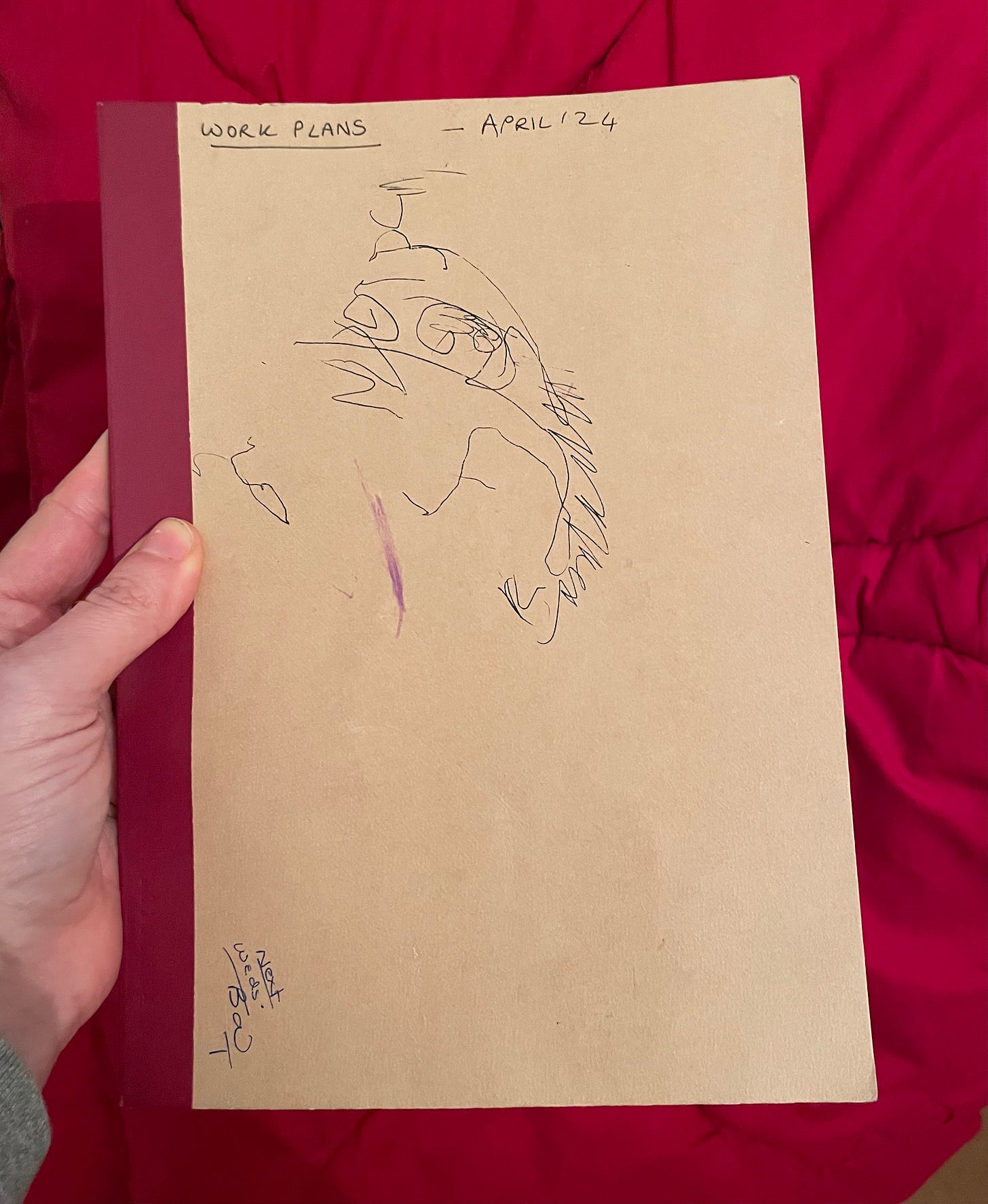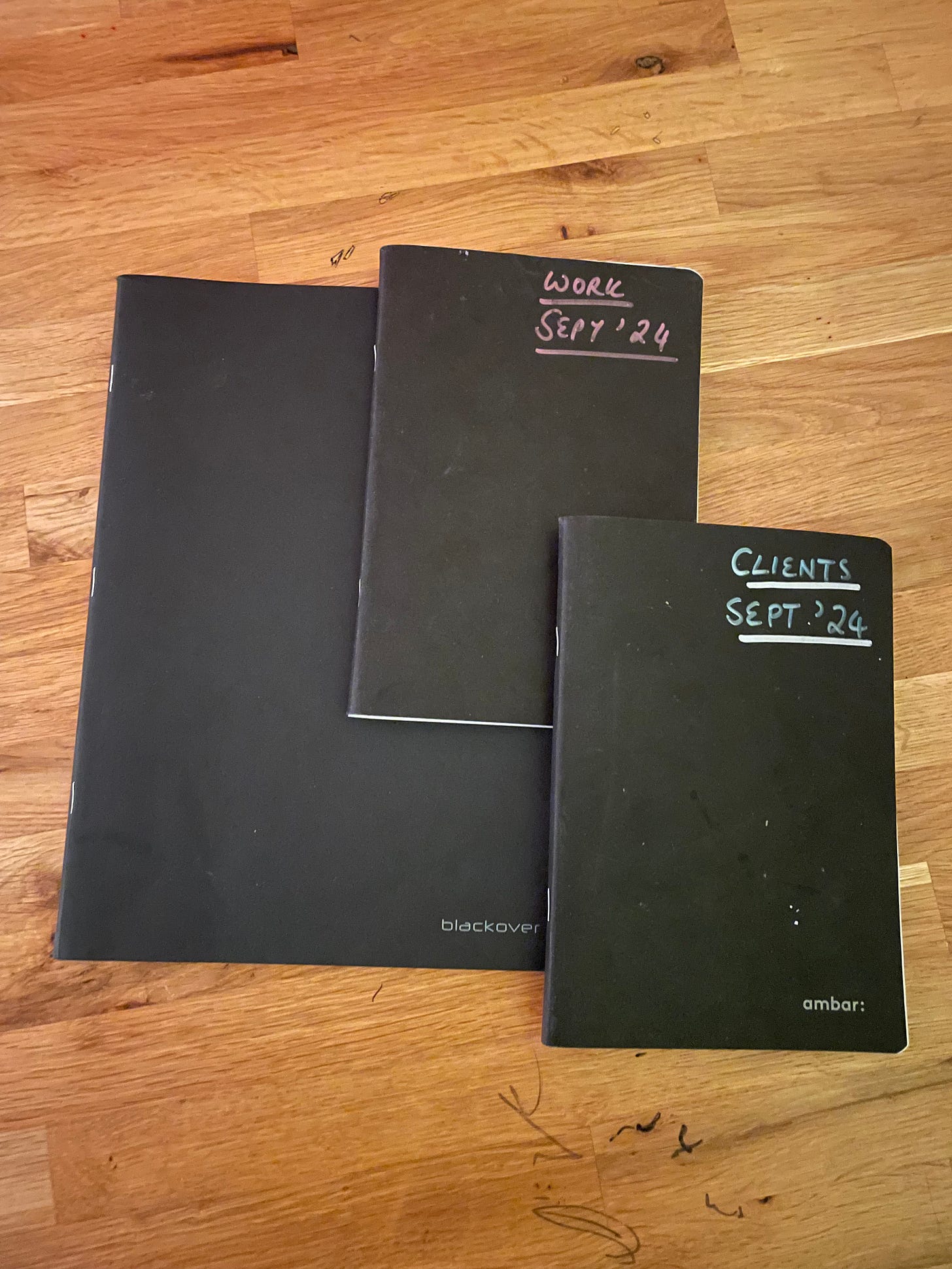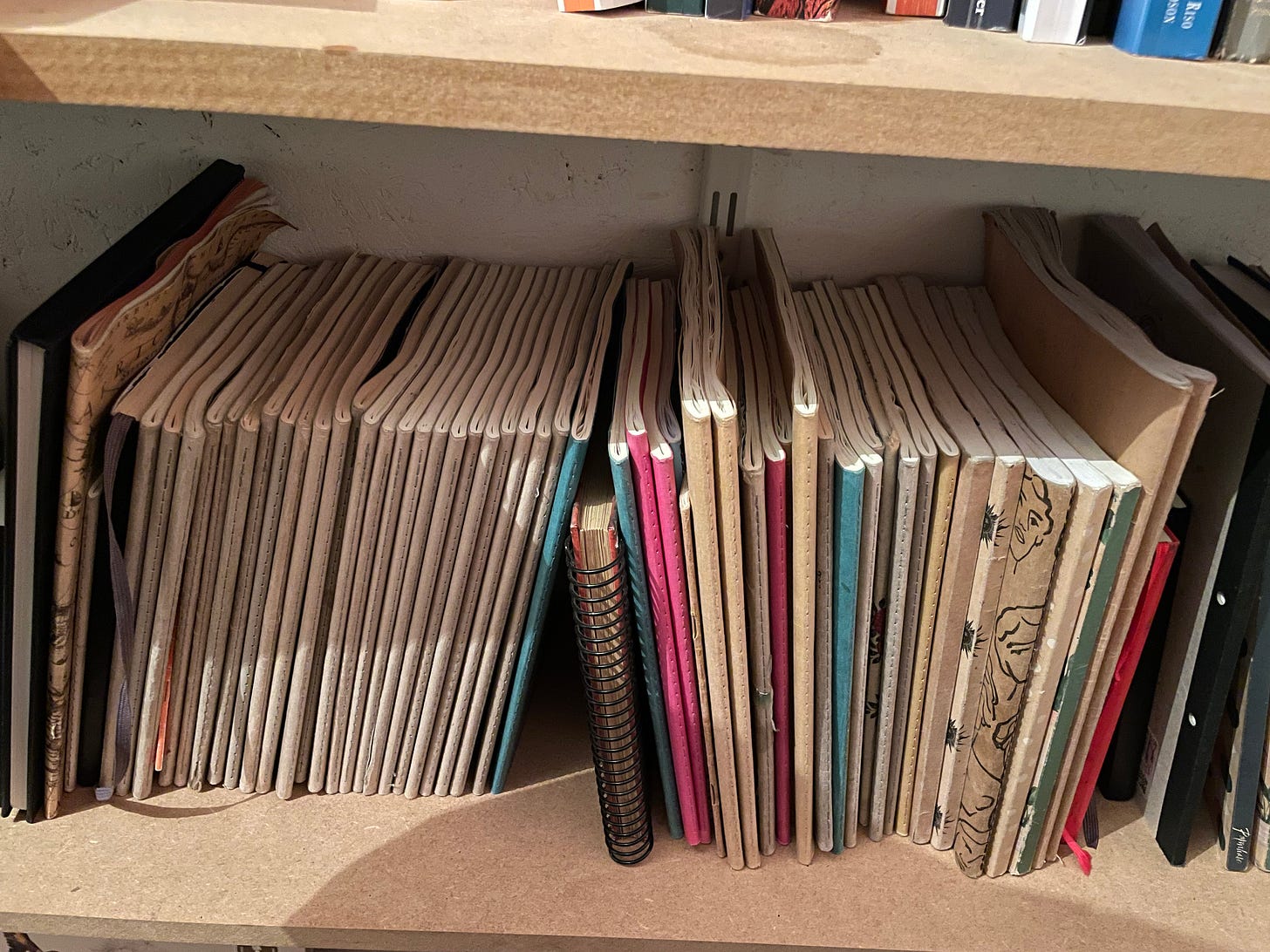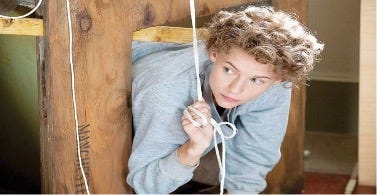A few uncontained thoughts on constraint and other kinds of pressure. (pt. 1)
Notebooks, procrastination and ways to let go.
A friend of mine who is a reiki healer is giving me a treatment. As she hovers over my solar plexus, hands warm and buzzy, I hear her draw breath.
“What?” I ask, anticipating she is about to tell me something is off in my vibe.
“Why are there…”. She pauses, clearly wondering at the vision she is having, then gestures to my stomach. “So many … notebooks?”
****
I am in my weekly writing group. I am intending to work on my book project. Usually, I write straight into the computer from whatever is in my head at the time. But today, I need to make notes, to think something through in sketchy handwritten form, maybe with different colours, before I commit it to the screen. As usual, everyone has their cameras switched off and we are working communally, but silently.
I go to my office to get the notebook that I have designated for my book project. I know what the notebook looks like – it is manila brown with either a yellow or peach spine. It is whatever the size is that is half of A4. I feel both impatient to get started and the particularly chemical form of anticipation of a need about to be met.* The need is the notebook. I come back to my computer. I sit down. I look down at the notebook. This is the wrong notebook. I go back. I look along my notebook shelf. I look on my desk. I look on the floor. This is the room where most of my notebooks live. I go to another room. I look on the bottom shelf where the other notebooks live. No notebook. Lots of notebooks but not the notebook. I go back to my desk. I sit down.
I feel weirdly diffuse and untethered from myself and a secret, yet familiar third situational thing of marching towards a task that I know will be creatively and intellectually satisfying, but that requires I collect one small object (the notebook) on the way, only to then be completely thwarted by the absence of that object. I cannot remember any of the things I was supposed to be writing about which, minutes ago, had seemed so shiny and connected and imminent and realisable. If this was a game of Sonic, which I remember very vaguely, having last played it in 1992, it would be one of those moments where you’re pinging through all the golden rings and then suddenly, out of nowhere, fall down some kind of pothole into the underwater bit, where you’re then just endlessly bouncing from one end of a pipe to another until the big red monster comes to get you.**
I briefly consider making notes in another notebook – one of the ones I use for a jumble of weekly work things, for example. Or even a new notebook. Or the wrongly identified notebook, just for the sake of its visual proximity to the missing one, if nothing else. I do not, or more to the point feel like I cannot do any of these things, all of which feel like surrendering to some chaotic version of myself and my writing practice which seems like such a defeat after I had put no inconsiderable amount of energy into selecting the perfect notebook for this writing project. I bobble around in the etheric realm that is between all the things I could be doing in this moment, not doing any of them fully.
25 minutes has passed. In the writing group we will all be turning our cameras back on soon and talking about how we have spent the time apart. I tap a few desultory words of my book into the screen and fiddle with some adverbs until my phone alarm goes off.
****
Because I like thinking about myself, because I like thinking about writing, because I like thinking about stationery and because I work as a mentor for artists, writers and academics, I spend a lot of time contemplating notebooks. I have always used them, and I have always had strict aesthetic rules for those I will use (those rules are also capacious, allowing me access to the largest possible number of notebooks):
1. they must not be spiral bound (too impermanent, too reminiscent of when I thought I wanted to be a journalist);
2. they must not have a shiny cover (vulgar);
3. they must not have words on the cover (particularly not ‘love is love’ or anything motivational or fun: notebooks should not be fun);
4. they must not be fluorescent (gross), the paper must not be too thin (I am heavy-handed) or too thick (will invariably mean fewer pages, also I like to flick).
I’ve had periods of only being able to use one brand and one colour – the Moleskine Cahier in Brisk Blue was a favourite for about 3 years; before that the Moleskine Cahier in Light Grey – which was both an expensive habit and made the issue of locating the right notebook for a moment even more arduous, particularly as I also had a tendency in these years of calling all my notebooks things like ‘work’ or ‘important stuff’, because it all was. Now, evolved human that I am, I’ve diversified to a range of notebook vibes and have recently, on trips to Lisbon, discovered these babies. They are perfect (matt cover, silky soft paper, floppy yet not flimsy to the touch) and cheap.
I love them.
At its most pleasurable, my notebook habit feels sensual, literary, organised, analogue, embodied. These are all affects I like and value. The sight of my notebooks, organised in chronological order, along my shelves, makes me feel like I have an archive. It weighs me down in a good way. More on this in a moment.
At its least pleasurable, my notebook habit makes me feel like my brain is spiralling out of control and fragmented. Where did I write that note? Where is that reference? Where is that thing I half started? That list? That idea? Where is the right notebook? Which is the right notebook? Should I just have one notebook? Why can I not contain myself?*** Like Anna Wulf in Doris Lessing’s The Golden Notebook , who tries to figure out and then integrate the different strands of her life through 4 separate notebooks (spoiler alert: she has a nervous breakdown), I can feel like the victim of my own systems or their proliferation at least. I know this is also about living under neoliberal capitalism with its peddled fantasies of maximised efficiency and self-regulation. I still wish I knew where my notebook was.
****
I watched a great film the other night – Temple Grandin, a true-life story of a woman (Temple Grandin, played brilliantly by Claire Danes in the film) growing up in the 1950s and 60s with autism. One summer, sent by her loving but exhausted mother to her aunt’s ranch, Temple has a panic attack when she realises somebody has been in her room and tidied it up. We see her rushing out into the farm, where she has been thriving – being more at ease with animals than she is with humans. She full-body hurtles into a mechanism called a squeeze chute, used to hold cattle in place when they need to be tagged or given medicine. Her aunt (CATHERINE O’HARA – in caps because it’s CATHERINE O’HARA) looks on in horror and confusion. Temple begs her aunt to tighten the squeeze chute around her. When she does, we see Temple’s whole physicality change. Her body slackens. Her face becomes calm. Euphoric even. We can see that, in this constraint, she is experiencing profound release and pleasure. This is good pressure.
As in the film, the real Temple Grandin went on to make her own prototype ‘hug machine’, based on the squeeze chute. Over time, she developed it, and it became a key component in her self-soothing protocol (she would keep it in her room).
She published an article about the hug machine which you can read here. In the article she writes of how it provided her with ‘deep touch pressure’:
[the] type of surface pressure that is exerted in most types of firm touching, holding, stroking, petting of animals, or swaddling. In contrast, light touch pressure is a more superficial stimulation of the skin, such as tickling, very light touch, or moving hairs on the skin. In animals, the tickle of a fly landing on the skin may cause a cow to kick, but the firm touch of the farmer's hands quiets her. Occupational therapists have observed that a very light touch alerts the nervous system, but deep pressure is relaxing and calming.
The accretion of examples alone in this passage feels like good deep touch pressure. As Grandin delineates, deep touch pressure (see also: swaddling babies, weighted blankets), is a way of the body being able to feel itself in space ( also known as proprioception) through the input of pressure from the outside. I don’t know if I have autism or not, but I do not always know where my body is in space, and this has always been thus. I feel very diffuse in my body a lot of the time, or I feel my body and mind to be very diffuse and extended and associative and buzzy round their edges. Sometimes this is great. Sometimes it means that I buy a lot of notebooks as a way of trying to sort all these associations into containers where, maybe, they will stay put. Sometimes that feels great too.
It’s not exactly the case that notebooks are my hug machines (hugs are probably my hug machines) but it’s not not true.
*****
Learning about deep touch pressure is making many things click for me about my body and my mind, and in the conversations I have with clients and friends about our bodies, our relationships, our work practices and processes. It gives me a frame for understanding why a wafty, light massage will make me feel livid with rage (really, there is no excuse for a wafty massage, and I hope never to give one). Why certain shibari ties (more on these soon but I’ve also written a little about my interest in shibari here) feel so ontologically soothing to let go into – particularly ones where parts of my body are folded and tied onto other parts of my body – and how other binds feel more psychologically challenging (anything where I’m spread out, basically – this might also be something to do with being hypermobile). Why yin yoga, where deep, often compressing positions like pigeon pose are held for a long time feels so good. Why, since being a kid, I have pressed my fingers into my forearms as a stress but also soothe response. Why, when encountering a new body in a loving context, my first urge is often to press it to see what is there. I can feel stories in the bodies that I am close to, and the way I feel them is through pressing. I don’t know what this is as an ability, but I know it is a true one.
Probably like any other free-wheeling gal with a disordered attachment style, I crave both containment and freedom and am not always sure how to create either for myself. In my mentoring work, too, I notice how often clients vacillate between these two states – for example, in their attitude to how they process ideas. Are they organised enough? How will they know when to stop with free associating an idea? Where are its edges? Where are their own? How do they fit themselves into the boxes of the grant proposal form / the website bio / the job interview without feeling constrained? Are they too much? Too little?
(Unsurprisingly, one of the things I find myself talking a lot about clients with in these sessions is the function of procrastination. But I’ll save that for another time. Let some pressure build up.)
****
I’ve been thinking about that missing notebook and the promise of containment that it extends but ongoingly fails to deliver (the notebook remains absent; I am trying not to obsess about it; this piece might suggest I am failing in that attempt). The book project continues but the mild feeling of an embodied flailing in space without this notebook remains. I know it’s ridiculous. I’d barely even started to fill it. When we turn our screens back on in my writing group, I tell them how I have spent my hour. Four understanding faces fill the screen. Everyone gets it and has their own version of it. Momentarily, I feel held. It is good.
*Dopamine.
**Like I said: vague recollection.
*** When we talk about notebooks we are definitely also talking about gender and we are definitely also talking about queerness.
With thanks to the wonders that are my friends in the Thursday morning writing club.
What I’ve been doing / thinking about, in addition to this piece:
I am very excited to have a piece, ‘capacities to read’ about tarot and fascism coming out in Greg Seigworth’s edited collection Capacities To: Affect Up Against Fascism with Imbricate! Press. Just in time for the US inauguration. The call for papers alone gave me full body tingles and it’s rare that a cfp would ever do that.
Sam Amsler and I bought an experimental creative writing platform! It’s called Beyond Form and we are so excited about co-stewarding it as a space for queer, devalued, misunderstood writers and artists. We’ve just put the finishing touch on our 2025 program and it’s going to be amazing. Follow us on Instagram to find out more.
Most of my revelations this week about yin yoga are because I have been taking part in this amazing space with Sonali Sangeeta Balajee, Sam Amsler and beautiful others. Find out more about the House of Yin here.
My mentoring books are open! If you would like to work with me, you can find out more about how I work here. Or get in touch!






Oh the notebook situation!! I can relate! So funny to read about it being the wrong one and how you couldn’t possibly get on with the work without it 🤣🤣 so true.
I used to get the vintage-looking school workbooks from the range, I’d buy one at a time as a sort of ritual 😂
After having a second child I found the only time I had to write was while feeding. I use a journalling app on my phone!!
It now cuts out transferring handwritten notes to digital and I don’t have to find my rose gold smooth writing pen. 😂
But my notebooks full of misery and neurosis (morning pages) might stay at three storage boxes forevermore!
Ahh the satisfaction of being squeezed!! Have you ever had a rebozo massage? ‘Closing of the bones’? I find it’s like a shamanic journey and cuddle from all your ancestors. ♥️❤️♥️❤️♥️❤️